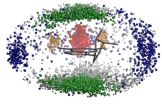(Press-News.org) If you think sleep problems and bladder problems are a fact of life in old age, you may be right. A new report appearing in the November 2014 issue of The FASEB Journal, shows that our sleep-wake cycles are genetically connected to our bladder, and disruptions to one may cause problems with the other. This discovery builds on the hypotheses that under normal circumstances, a primary clock located in the brain controls several other peripheral clocks located throughout the body. These peripheral clocks, in turn, control the activity of functional proteins and receptors, including those in the bladder.
"We hope our study will stimulate further progress in understanding circadian control of body physiology and aging-related dysfunction and ultimately lead to new strategies of treatment by targeting the circadian regulatory process, including non-drug treatment approaches," said Changhao Wu, M.D., Ph.D., a researcher involved in the work from the Department of Biochemistry and Physiology at the University of Surrey in the United Kingdom.
To make this discovery, scientists used genetically modified mice in which a special wavelength of light was emitted when the clock proteins were produced in isolated bladder tissue. This light reported real-time clock expression and acted directly as a measure of peripheral clock expression. Over 24 hours, changes in clock expression were recorded in the presence and absence of the receptor activators. Rhythmic clock activities occurred in the bladder wall with a cycle around 24 hours and peaked at about hour 12. Application of these receptor activators shifted the peak of the clock expression to an earlier time. In older mice, the clock expression and its response to the activators were significantly dampened. Bladder contractions also exhibited circadian rhythms, similar to changes of the clock expression. The contractile function in the bladder can be regulated by the local circadian clocks, which are in turn under the feedback control of the output receptors. This reciprocal control of clock function represents an important mechanism for maintaining physiological function in the peripheral hollow organs and its dysregulation may contribute to abnormal motility in age-related disorders such as overactive bladder.
"It's hard to appreciate how much of a problem an overactive bladder can be," said Gerald Weissmann, M.D., Editor-in-Chief of The FASEB Journal. "It disrupts many aspects of life, from the obvious, like sleep and travel, to the less obvious, like exercise and entertainment. This study helps us understand what's causing the problem, and points the way to a solution."
INFORMATION:
Receive monthly highlights from The FASEB Journal by e-mail. Sign up at http://www.faseb.org/fjupdate.aspx. The FASEB Journal is published by the Federation of the American Societies for Experimental Biology (FASEB). It is among the most cited biology journals worldwide according to the Institute for Scientific Information and has been recognized by the Special Libraries Association as one of the top 100 most influential biomedical journals of the past century.
FASEB is composed of 27 societies with more than 120,000 members, making it the largest coalition of biomedical research associations in the United States. Our mission is to advance health and welfare by promoting progress and education in biological and biomedical sciences through service to our member societies and collaborative advocacy.
Details: Changhao Wu, Guiping Sui, Simon N. Archer, Paolo Sassone-Corsi, Karen Aitken, Darius Bagli, and Ying Chen. Local receptors as novel regulators for peripheral clock expression. FASEB J. November 2014 28:4610-4616; doi:10.1096/fj.13-243295 ; http://www.fasebj.org/content/28/11/4610.abstract
Clock gene dysregulation may explain overactive bladder
New research in The FASEB Journal suggests that the regulation of circadian clock genes by receptors involved in contractile organs shows that the daily cycle can be altered by activation of these receptors
2014-10-30
ELSE PRESS RELEASES FROM THIS DATE:
Patents for humanity: Special edition of Technology and Innovation
2014-10-30
TAMPA, Fla. (Oct. 30, 2014) – The current special issue of Technology and Innovation, is devoted to patents that benefit people around the world who live with limited resources, in challenging environments, and are in need of better access to basic needs and improved standards of living, health and infrastructure.
The issue includes original articles from winners of the 2013 USPTO Patents for Humanity Awards, aimed at rewarding innovators for deploying patented technologies to address humanitarian needs. Winners featured in the issue include SIGN Fracture Care International, ...
Lou Gehrig's disease study: Renewing brain's aging support cells may help neurons survive
2014-10-30
LOS ANGELES (Oct. 29, 2014) – Lou Gehrig's disease, also known as amyotrophic lateral sclerosis, or ALS, attacks muscle-controlling nerve cells – motor neurons – in the brain, brainstem and spinal cord, leading to progressive weakness and eventual paralysis of muscles throughout the body. Patients typically survive only three to five years after diagnosis.
Now, with publication of a study by investigators at the Cedars-Sinai Board of Governors Regenerative Medicine Institute, ALS researchers know the effects of the attack are worsened, at least in part, ...
Smithsonian scientist discovers populations of rare songbird in surprising new habitat
2014-10-30
The Swainson's warbler (Limnothlypis swainsonii) is one of the rarest and most secretive songbirds in North America, prized by birdwatchers in the southeastern U.S. hoping to catch a glimpse of it in the wild or hear its beautiful ringing song. With only 90,000 breeding individuals sparsely distributed across 15 states in the U.S., the Swainson's warbler is a species of high conservation concern that, for decades, has left conservationists with little confidence that its populations would ever be fully secure.
However, new research published in the Oct. 30 edition of ...
National initiative shows multisystem approaches to reduce diabetes disparities
2014-10-30
Washington, DC – Exciting results from an innovative, multicultural, five-year initiative, known as the Alliance to Reduce Disparities in Diabetes (Alliance), have been published in ten peer-reviewed articles in the November 2014 supplemental issue of Health Promotion Practice (HPP). The findings reveal that a new model of chronic disease management for vulnerable populations with diabetes shows significant promise in strengthening coordination of care, reducing diabetes health disparities and improving health outcomes.
Funded by Merck Foundation, the Alliance ...
Model by NIH grantees explains why HIV prevention dosing differs by sex
2014-10-30
WHAT:
A mathematical model developed by NIH grantees predicts that women must take the antiretroviral medication Truvada daily to prevent HIV infection via vaginal sex, whereas just two doses per week can protect men from HIV infection via anal sex. This finding helps explain why two large clinical trials testing HIV pre-exposure prophylaxis, or PrEP, in women failed to show efficacy. Participants in the VOICE and FEM-PrEP trials of Truvada and tenofovir (another antiretroviral) for HIV prevention were counseled to take one of the medications daily. However, because they ...
Seeing dinosaur feathers in a new light
2014-10-30
Why were dinosaurs covered in a cloak of feathers long before the early bird species Archaeopteryx first attempted flight? Researchers from the University of Bonn and the University of Göttingen attempt to answer precisely that question in their article "Beyond the Rainbow" in the latest issue of the renowned journal Science. The research team postulates that these ancient lizards had a highly developed ability to discern color. Their hypothesis: The evolution of feathers made dinosaurs more colorful, which in turn had a profoundly positive impact on communication, ...
The geometry of RNA
2014-10-30
Messenger, transfer, ribosomal... there's more than one type of RNA. The difference lies not only in the sequence of the nucleotides, the "beads" that form the strand, but also in the three-dimensional structure that this long molecule takes on. Computer models are often used to reveal this structure but these tend to be rather complex, and they vary depending on the field of application. A team of SISSA scientists used numerical techniques to develop a new "geometrical" model which has the advantage of being much simpler and faster than those traditionally used as well ...
Cochrane Review of RDT for diagnosis of drug resistant TB
2014-10-30
Researchers from the Cochrane Infectious Diseases Group, hosted at LSTM, have conducted an independent review to examine the diagnostic accuracy of the GenoType® MTBDRsl assay for the detection of resistance to second-line anti-tuberculosis drugs.
While there are a number of different drugs available to people suffering from tuberculosis (TB), resistance to these drugs is a growing problem. People suffering from a drug-resistant strain of TB are more likely to die from the disease, and require treatment with what are described as "second-line" drugs. These drugs can ...
New tech aims to improve communication between dogs and humans
2014-10-30
North Carolina State University researchers have developed a suite of technologies that can be used to enhance communication between dogs and humans, which has applications in everything from search and rescue to service dogs to training our pets.
"We've developed a platform for computer-mediated communication between humans and dogs that opens the door to new avenues for interpreting dogs' behavioral signals and sending them clear and unambiguous cues in return," says Dr. David Roberts, an assistant professor of computer science at NC State and co-lead author of a paper ...
Ion adsorption matter in biology
2014-10-30
New York | Heidelberg, 30 October 2014 Biological membranes are mainly composed of lipid bilayers. Gaining a better understanding of adsorption of solution ions onto lipid membranes helps clarify functional processes in biological cells. Now, a new study provides a quantitative description of the equilibria between lipid membranes and surrounding solution ions. Joanna Kotyńska and Zbigniew Figaszewski from the University of Bialystok, Poland, are the authors of a study describing these findings, just published in EPJ E. In addition to shedding some light on biological ...
LAST 30 PRESS RELEASES:
Targeting specific protein regions offers a new treatment approach in medulloblastoma
$2.7 million grant to explore hypoxia’s impact on blood stem cells
Cardiovascular societies propel plans forward for a new American Board of Cardiovascular Medicine
Hebrew SeniorLife selected for nationwide collaborative to accelerate system-wide spread of age-friendly care for older adults
New tool helps identify babies at high-risk for RSV
Reno/Sparks selected to be part of Urban Heat Mapping Campaign
Advance in the treatment of acute heart failure identified
AGS honors Dr. Rainier P. Soriano with Dennis W. Jahnigen Memorial Award at #AGS24 for proven excellence in geriatrics education
New offshore wind turbines can take away energy from existing ones
Unprecedented research probes the relationship between sleep and memory in napping babies and young children
Job losses help explain increase in drug deaths among Black Americans
Nationwide, 32 local schools win NFL PLAY 60 grants for physical activity
Exposure to noise – even while in the egg – impairs bird development and fitness
Vitamin D availability enhances antitumor microbes in mice
Conservation actions have improved the state of biodiversity worldwide
Corporate emission targets are incompatible with global climate goals
Vitamin D alters mouse gut bacteria to give better cancer immunity
Escape the vapes: scientists call for global shift to curb consumer use of disposable technologies
First-of-its-kind study definitively shows that conservation actions are effective at halting and reversing biodiversity loss
A shortcut for drug discovery
Food in sight? The liver is ready!
Climate change could become the main driver of biodiversity decline by mid-century
Voluntary corporate emissions targets not enough to create real climate action
Curiosity promotes biodiversity
Warming Arctic reduces dust levels in parts of the planet
New MSU research finds paid family leave helps prevent child abuse
Endocrine Society names Andrews as new Editor-in-Chief of Endocrinology
Type of surgery and its risk level has significant impact on complications and death in elderly patients
National Center to Reframe Aging teams up with Longevity Ready Maryland Initiative
Study reveals racial disparities in COVID-19 testing delays among healthcare workers
[Press-News.org] Clock gene dysregulation may explain overactive bladderNew research in The FASEB Journal suggests that the regulation of circadian clock genes by receptors involved in contractile organs shows that the daily cycle can be altered by activation of these receptors



